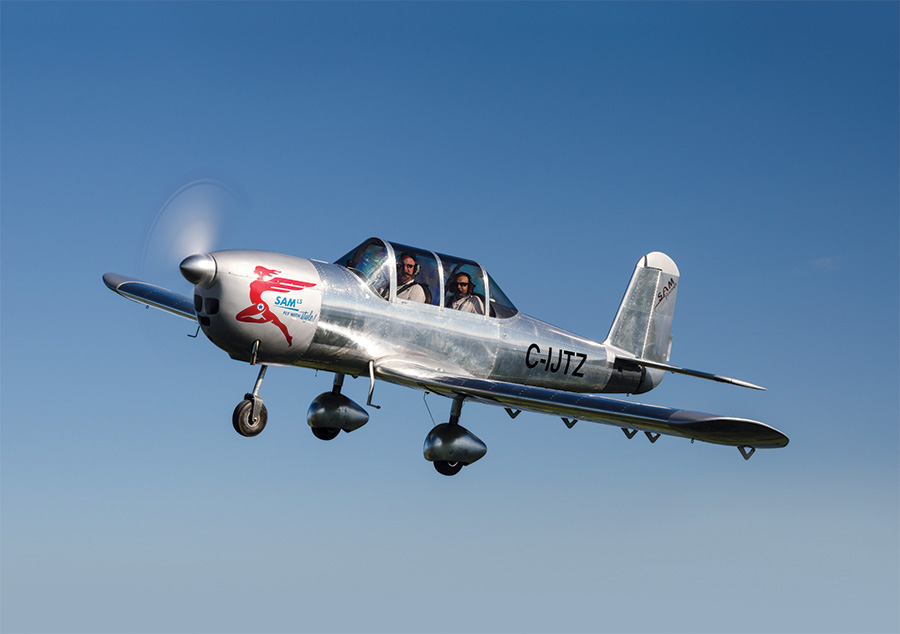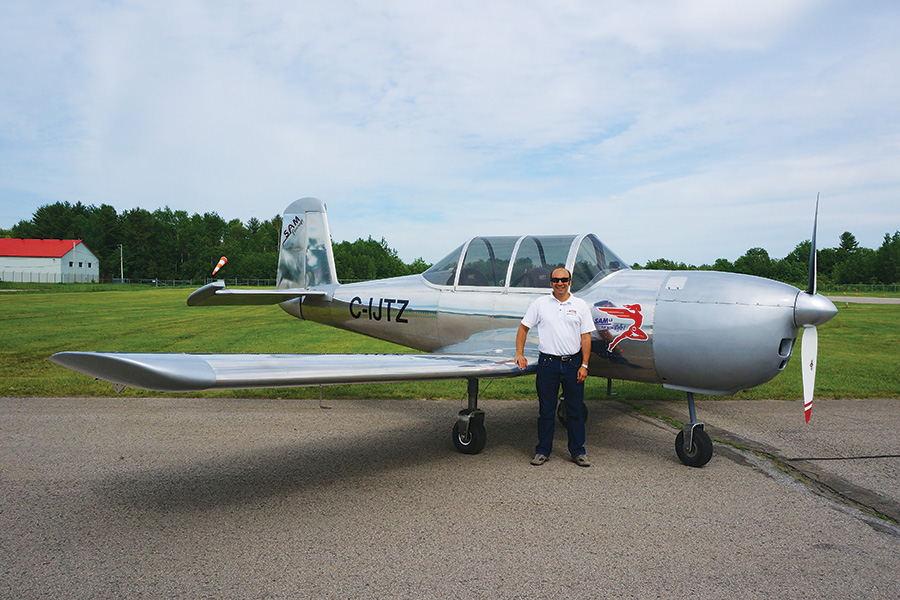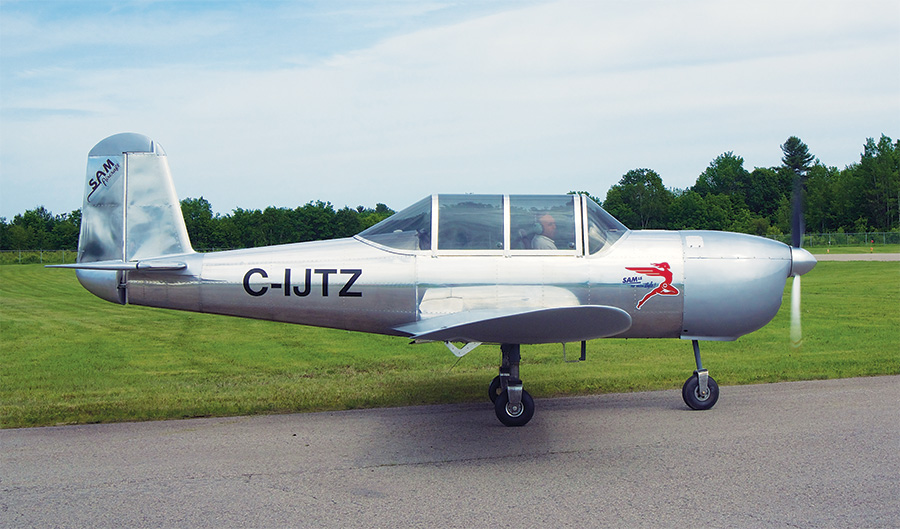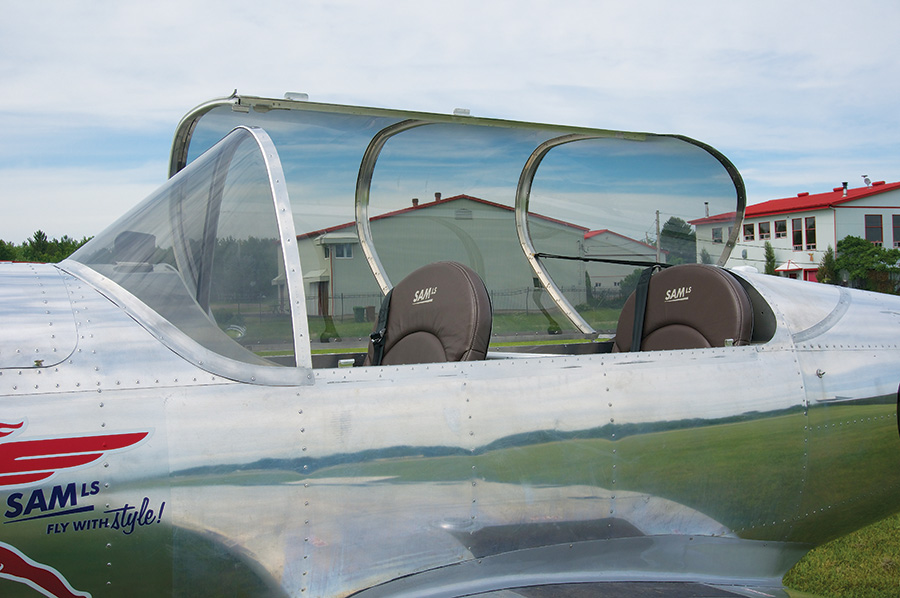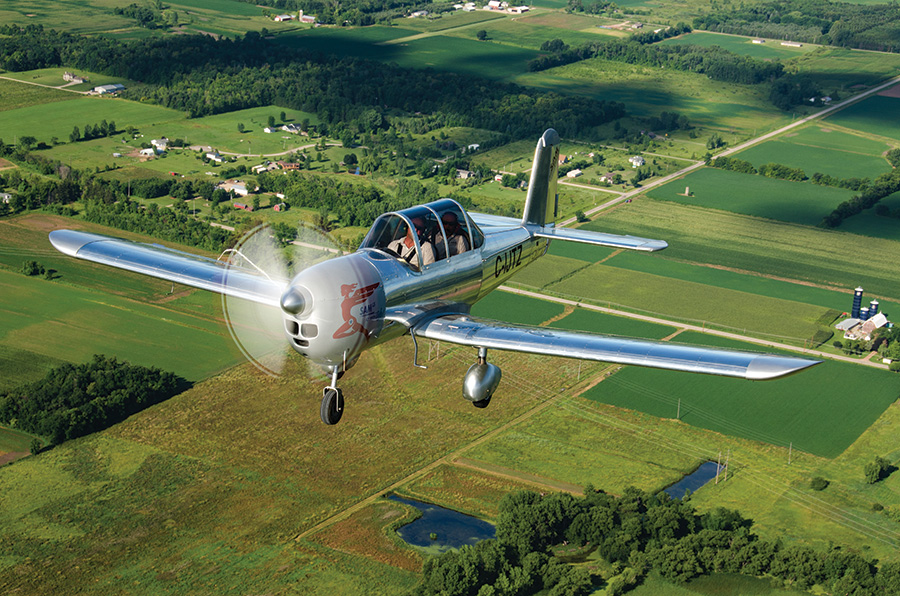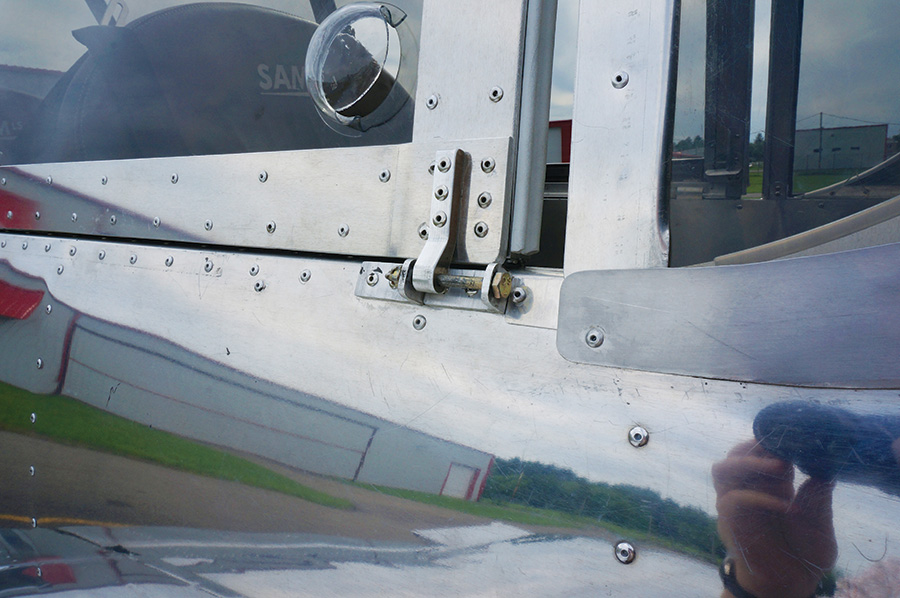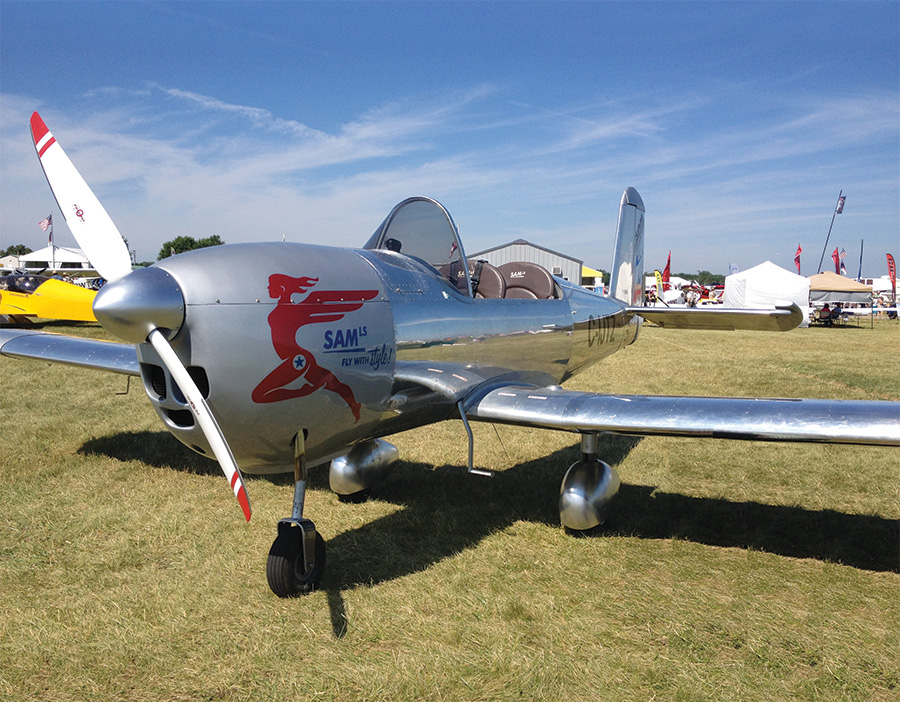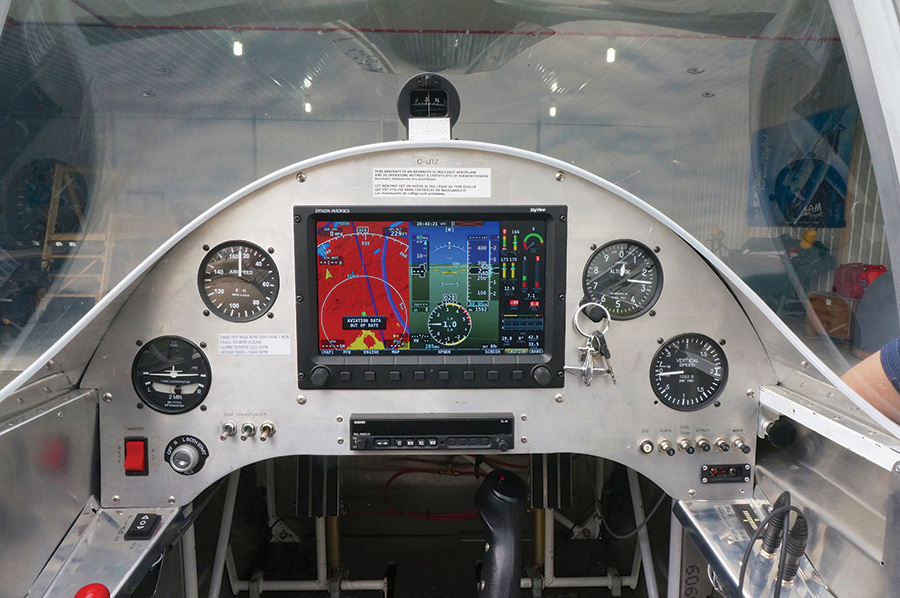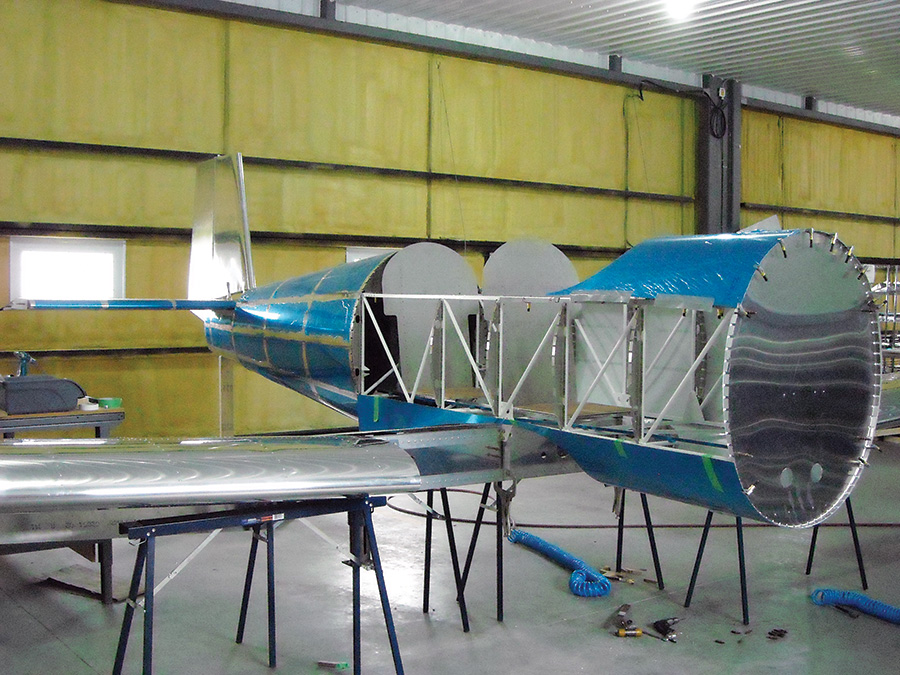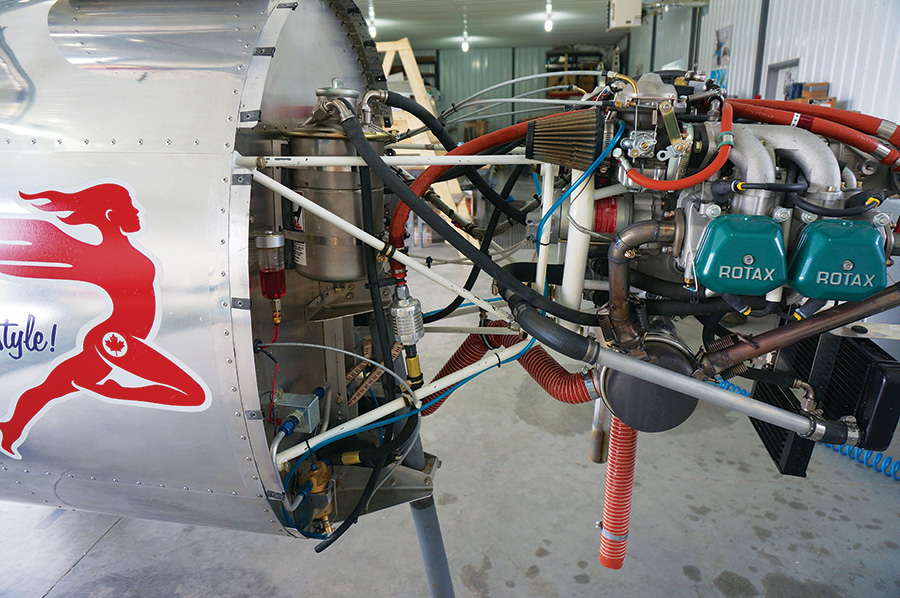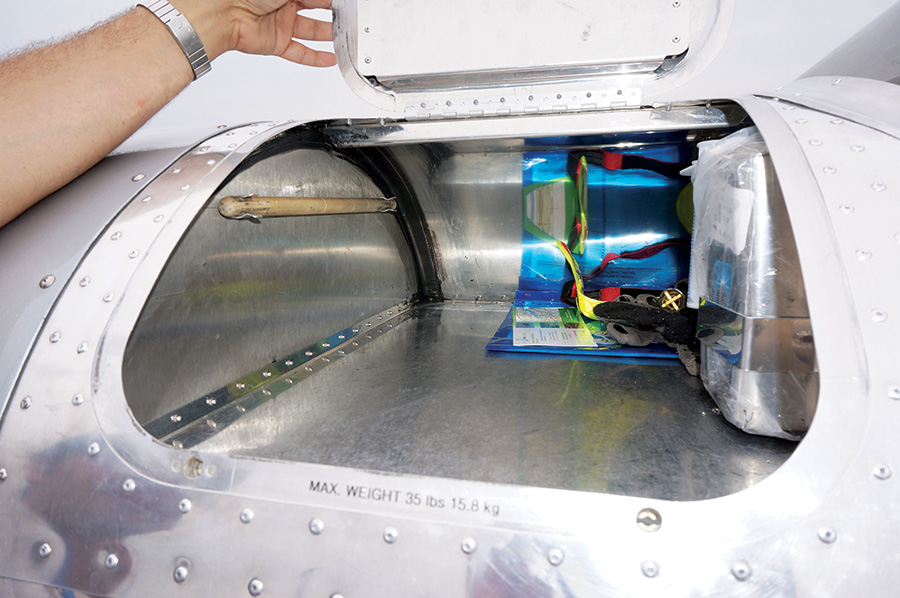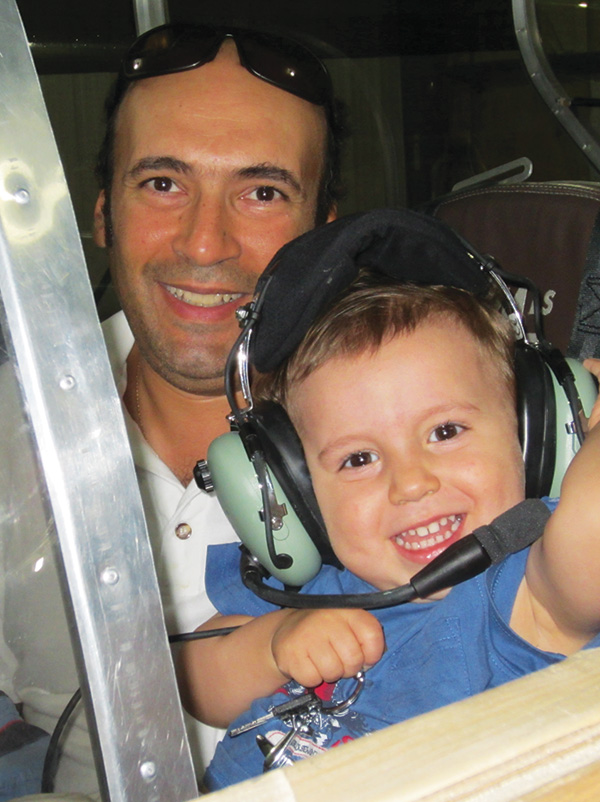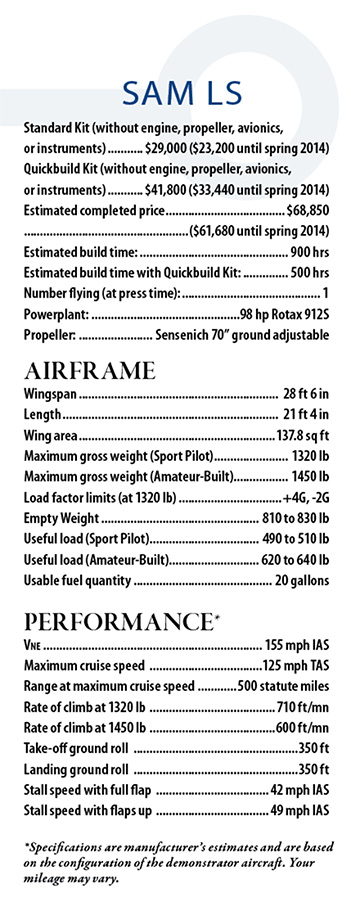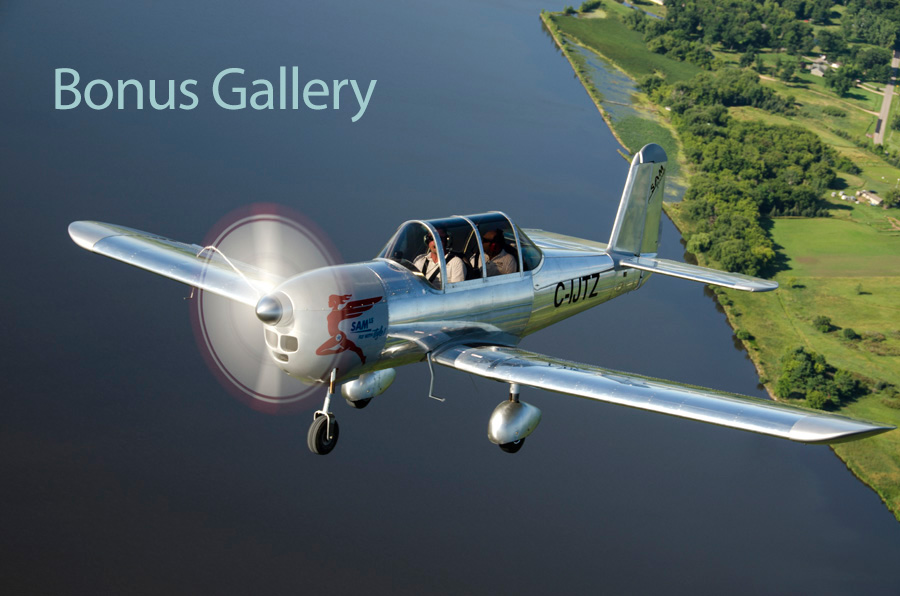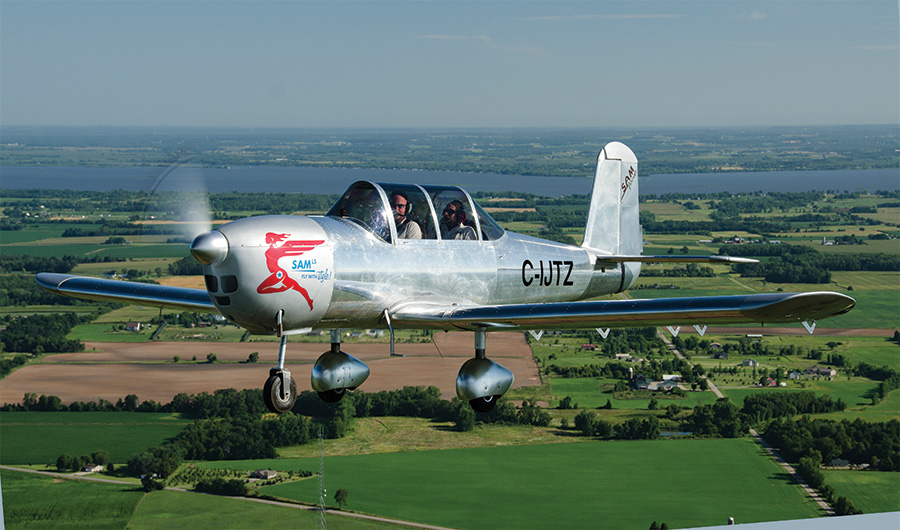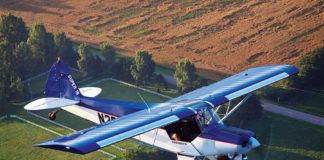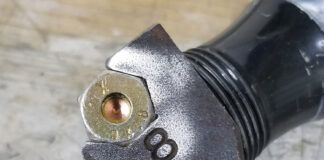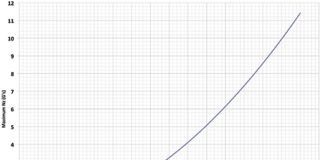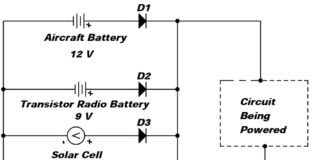The LSA Aircraft market is starting to look a bit crowded to these eyes, with many dozen aircraft types. There are a few popular classes of aircraft, with a rather large number of composite, high-wing, side-by-side, tricycle-landing-gear types, and numerous tube-and-fabric, high-wing, tail-dragger, Cub-like types. Both categories have some popular models, but woe to any new manufacturer who hatches a similar new bird. It would have to be a real peacock to stand out in that crowd.
SAM Aircraft wisely chose to produce something different, all the easier to be noticed. The SAM LS is inspired by the Ryan STA (a gorgeous, low-wing, tandem-seating taildragger from the 1930s), but the prototype has tricycle landing gear so it looks more like a smaller Varga Kachina than it does the Ryan.
Romantic Inspiration
SAM Aircraft hails from Lachute, Quebec, about a 45-minute drive NW of Montreal, but the company has its roots across the pond in France. Company founder Thierry Zibi learned to fly at La Ferte-Alais Aeroclub, just south of Paris. La Ferte-Alais is best known for the annual airshow highlighting classic, antique, and warbird aircraft. After learning to fly, Zibi got the bug to design his own aircraft, and was attracted to some of the classic monoplanes from the era between WW-I and WW-II.
Thierry was especially smitten with the Ryan STA; and when he finally saw one in the flesh, he knew he had found the inspiration for his design. But if he wanted to market his aircraft, it had to fit into the available regulatory frameworks. The ultralight category in France was popular, but the maximum take-off weight (992 pounds) would be a serious impediment. The situation was much better in North America—Advanced Ultralight Aircraft (AULA) in Canada and Light Sport Aircraft in the USA had maximum takeoff weights of 1232 pound and 1320 pounds respectively. The Quebec government views aviation as a generator of economic activity, so they offered financial assistance if SAM Aircraft was established there. Decision made—in 2009 Thierry moved to Montreal, Canada’s aviation hotbed, with Bombardier, Bell Helicopter Canada, Pratt & Whitney Canada, and many dozen smaller companies in the area.
Once in Montreal, Thierry made contact with several engineers, managers, and technicians with extensive experience in the aviation industry, who were able to assist in turning his concept into a design, and finally a real aircraft. The prototype was built to meet Canadian AULA design standards, as this provided a proven market, and was close enough to LSA to facilitate eventual approval in that category.
The Aircraft
All aircraft are compromises, to one extent or another. Want to go really fast? That drives you to a light aircraft, with minimal wing area and a large engine, which means a tight cockpit, reduced baggage space, etc. The reduced wing area will lead to a higher stall speed and increased takeoff and landing distances. Want a roomy cockpit and lots of baggage area? That leads to a larger fuselage, a higher weight, which requires a larger wing, which means even more weight, which leads to an even larger wing, etc. The resulting aircraft will have a slower cruise speed than the one optimized for high speed.
The art of design is about balancing the various compromises to achieve a resulting product that best meets the needs of the target market. SAM Aircraft has chosen a different set of compromises than many other aircraft aimed at the LSA market, which means their aircraft will answer a slightly different set of market needs than much of their competition. Have they chosen wisely? The only true answer to that question can come from the response of the market. All we can do at this stage is shed some light on the various choices SAM has made, and the effect these choices had on the aircraft.
The right-hinged canopy provides good access to both seats. The design has been updated since this photo to include two shoulder straps on each seat.
Choose Your Wing…
The aircraft was designed from the very start to have several variants. The fuselage, tail, and wing center section are common between all variants. The outer wings and landing gear differ. Eventually there will be three different wingspans, the landing gear can be either tricycle or tailwheel, and the aircraft can have a full canopy or an open cockpit with windscreen. If the full canopy is purchased, it can be quickly removed and reinstalled to convert back and forth to the open-cockpit configuration. The prototype has the mid-length wings (28-foot 7-inch span), tricycle landing gear, and a canopy (Winters are cold in Quebec!). This wing is stressed for up to 4 G flight load (6 G ultimate load, with 1.5 factor of safety) at 1320 pounds gross weight, and 3.6 G flight load at 1450 pounds. The next variant will be the SAM CC with a shorter 25-foot 3-inch wingspan. The final variant will be the SAM STOL, with a longer 31-foot 10-inch span, stressed for 1320 pounds.
The wing center section was designed for the loads imposed by the worst case of the various wingspans, and the tail was also sized to provide adequate stability and control for the worst-case variant. This means that the other variants are carrying a bit of extra weight that would not be required if the design had been fully optimized for each. The flip side of this compromise is that the parts commonality between variants should result in increased economies of scale and reduced unit costs.
The aircraft was designed to meet the LSA requirements when fitted with the long- and mid-length wings. But SAM Aircraft has not yet submitted the design for LSA approval. SAM Aircraft will submit the design for LSA approval once there is market demand for an SLSA or ELSA aircraft. The aircraft is marketed as an amateur-built kit, stressed and tested for up to 1450 pounds gross weight. The aircraft meets the U.S. Sport Pilot requirements if the builder declares a 1320 pound gross weight. The SAM LS has also received approval under the Canadian AULA requirements at a 1232-pound gross weight. However, an AULA approval leaves only a 402-pound useful load, based on the 830-pound empty weight of the prototype aircraft (without wheelpants), which makes it effectively a single-place aircraft, unless both occupants are quite light.
…and Choose Your Look!
The aircraft is designed to be built with either tricycle or taildragger landing gear. This decision should be made before the aircraft is constructed, as it would be a significant task to convert a completed aircraft from one to the other due to the way the main landing gear is attached to the wing center section structure. The prototype has tricycle landing gear, but SAM hopes to convince a local builder to construct a taildragger soon, so this variant can be assessed.
The robust-looking main and nose landing gear legs are fabricated from large-diameter steel tubes which use nylon inserts to provide low friction for the telescoping action. Bungee cords provide the shock action. The hydraulic Matco brakes are controlled by conventional toe brakes on the front seat rudder pedals. Nosewheel steering is via the rudder pedals, with a spring bungee to provide an appropriate amount of give between rudder pedals and nosewheel.
The three canopy hinge bolts can be quickly removed to put the aircraft in an open cockpit configuration.
The forward fuselage contains a 4130 steel protection cage that extends from the firewall to just behind the rear seat. The protection cage carries the structural loads in this area, and also protects the occupants in the event of an accident. Aluminum bulkheads are attached to the protection cage to support the aluminum skin. The rear fuselage, wings, and tail surfaces are semi-monocoque aluminum structures. A baggage stowage area extends the full width of the forward fuselage, above the rudder pedals, and is accessed via a hinged door on the left side.
Ailerons and elevators are controlled by front- and rear-seat control sticks via pushrods and bellcranks. Front- and rear-seat rudder pedals are connected to the rudder via cables. Electric elevator trim is controlled by a rocker switch on the control stick. Electrically-powered flaps are controlled by a switch on the left side of the instrument panel. The switch is well placed so that it is reached with minimal movement of the left hand from its natural position on the throttle.
The prototype has a 98-horsepower Rotax 912S, which is mounted on a long engine mount, way ahead of the firewall. The aircraft was designed so that a heavier engine, such as a Lycoming IO-233, could be used on a shorter engine mount. Mounting the heavier engine farther aft would help keep the empty CG in the right place. The cowling has a constant cross section near the aft edge, so it will still fit the firewall if it has to be trimmed to accommodate an engine on a shorter mount.
There is an 11-gallon fiberglass fuel tank in each wing, mounted between the front and rear spars, giving 22 gallons total capacity. One gallon per side is only usable in straight and level flight due to the flat bottoms on the fuel tanks, so the usable fuel is 20 gallons. The fuel selector on the lower left side of the cockpit has left, right, and off selections. An electric boost pump and an engine-driven mechanical fuel pump provide fuel pressure for the two carburetors. A small orifice in the fuel distribution manifold between the mechanical fuel pump and the carburetors allows some fuel (and any fuel vapor) to return to the left fuel tank. Thus if the tanks are full, some fuel should be used from the left tank first to make room for the returned fuel. If the flight plan requires using most of the available fuel, the right tank should be emptied first, so the return fuel is going back into the active tank at the end of the flight.
The prototype has a single 10-inch Dynon SkyView EFIS on the front instrument panel for primary flight instruments and engine instruments. The SkyView is supplemented by a round-dial airspeed indicator, altimeter, VSI, turn coordinator, and magnetic compass. The Dynon transponder is controlled via the SkyView, and the com radio is a Garmin SL40.
The prototype has an empty weight of 830 pounds, but it does have relatively heavy leather seats and armrests, and both EFIS and backup analog instruments. SAM Aircraft calculates that a more spartanly finished aircraft would be approximately 20 pounds lighter. With an empty weight of 810 to 830 pounds, the aircraft can carry 358 to 378 pounds of occupants and baggage, plus full fuel, at a gross weight of 1320 pounds. If the builder foregoes Sport Pilot limits, and declares a 1450-pound gross weight, the available weight for occupants and baggage increases to 488 to 508 pounds with full fuel, making it a very practical two-person cross-country aircraft.
In the Air
Enough talking. Time to finally go flying! The aircraft is easily pushed out of the hangar using a hand tow bar on the nosewheel. As with all Rotax 912 engines, the prop should be turned several times to pump oil from the engine to the dry sump oil tank prior to checking the oil level. Coolant level is checked through the same door as the oil level. All other walkaround items are completely standard.
The cockpit is accessed from in front of the left wing, using the fixed step that hangs down from the forward fuselage. Put the left foot on the step, grasp the canopy sill, step up, and place the right foot on the wing walk area behind the main wingspar. Step onto the seat and into the cockpit. It’s ten times easier than getting into the back seat of my RV-8. Both front and rear seats adjust fore and aft to accommodate different pilot leg lengths. Both seats have four-point harnesses (three-point harnesses were installed at the time of the flight review, but the design has since been updated to four point).
The right side hinged canopy is latched by lowering it to the sill, pushing forward to engage the securing hooks, then locking it in place with a lever that prevents aft movement. The canopy is very high, allowing adequate headroom for pilots with very long torsos. The aircraft can be quickly converted to an open-cockpit configuration by removing the three canopy hinge bolts. The fixed windscreen provides good protection for the front seat, but the rear seat would likely be a windy place. A creative builder could possibly craft a suitable removable rear seat windscreen. SAM reports that the aircraft is approximately 10 mph slower when flown with the canopy removed.
The rear seat controls include throttle, stick, and rudder pedals. The rear seat rudder pedals are reached by putting the feet in tunnels beside the front seat. These tunnels are somewhat narrow, and those with extra wide feet may find they don’t fit in the tunnels. My 43/8-inch wide, size-10 running shoes barely made it. SAM is investigating mods to make these tunnels wider, but that may not be possible due to the constraints of the cockpit protection cage and front seat structure.
The Rotax 912S is mounted well ahead of the instrument panel, providing easy maintenance access. This also allows a heavier engine to be mounted further aft, keeping the empty CG in the right range.
The engine start is standard Rotax 912. Throttle idle, fuel pump on, choke on (only if the engine is cold), then turn the key to start. Warm-up is at 2500 rpm, releasing the choke as the engine warms up. The runup consists of an ignition check at 4000 rpm.
The aircraft is a joy to taxi. The nosewheel steering is controlled via the rudder pedals. A bit of brake will assist to allow very tight turns if required. There is excellent visibility from the cockpit during taxi.
The baggage bay is above the rudder pedals, and is accessed via a top-hinged door on the left side of the fuselage.
The takeoff weight was close to 1320 pounds. Takeoff was accomplished with the flaps retracted, with a rotate speed of 65 mph, transitioning to a climb speed of 75 mph. The combination of nosewheel steering and aerodynamic control from the rudder made it easy to track the runway centerline. SAM has conducted takeoffs with up to a 15-mph crosswind, but it is likely that the actual aircraft crosswind capability is quite a bit higher than that. The normal climb speed is 75 mph. The long cowling blocks the visibility directly ahead in the climb, so S-turns are advised to ensure there is no traffic ahead. The observed climb performance on this warmer-than-standard day was consistent with SAM’s claimed climb rate of 710 feet per minute at a 1320 pound weight at sea level on a 59 F (15 C) day.
The large canopy provides excellent visibility during cruise. The prototype has large pop-out fresh air vents in the canopy. These provide adequate fresh air for a Canadian summer day, but operators in Texas may prefer to fly with the canopy removed. The observed cruise speed of 120 mph IAS at 3500 feet is respectable, especially considering that the SAM LS is quite large for an LSA. The prototype did not yet have wheelpants covering the landing gear—SAM reported from later testing that the large wheelpants increased the cruise speed less than 1 mph. Note that the airspeed system has not been calibrated, so no attempt was made to convert IAS to TAS.
The aircraft responds well to flight-control inputs, with pleasantly light aileron forces and moderately sporty roll rates. The differential Frise ailerons do a good job of minimizing adverse yaw, so little rudder input is required during turn entry and exit. The aircraft has neutral spiral stability, holding bank angle if the stick is released, assuming the fuel load is balanced between the left and right tanks. The aircraft has good directional stability and control. The dihedral effect is on the low end of the normal range; if the pilot steps on the rudder, there is some resulting roll rate, but the roll response is slow.
Pitch stability and control is excellent. The stick forces in pitch are a happy medium between tiring and twitchy. A change in speed without retrimming requires moderate stick force, showing good static longitudinal stability. There is little friction in the pitch control system, so the free return speed is very close to the original trimmed speed, if the stick force is slowly released.
If the stick is released with the aircraft off the trimmed speed, the resulting roller coaster phugoid motion is positively damped, and the phugoid period is normal for aircraft of this speed. The electric pitch trim is controlled via a rocker switch on the stick, and the trim rate strikes the right balance between painfully slow and overly sensitive.
The SAM LS has a 15% thick NACA 23015 airfoil; the Van’s RV-4 through RV-8 have a 13.5% thick version of the same airfoil. Not surprisingly, the SAM LS has very similar stall characteristics to these RVs. The stick forces build progressively as the aircraft decelerates. With the flaps up, there is strong buffet about a half mph prior to the stall, which occurred at 47 mph IAS with power at idle. The nose drops at the stall, but there is no wing drop. The wing starts flying again as soon as the stick is moved forward to reduce the angle of attack. With the flaps extended, weak stall warning buffet starts about 3 mph prior to the stall, with the stall at 42 mph. Once again, the nose drops at the stall, but there is no wing drop, and stall recovery is immediate once the pilot moves the stick forward. Stall characteristics in turns and with power on were similar. All in all, the SAM LS has excellent stall characteristics, but marginal stall warning.
Ideally, it would be better to have stall warning come earlier, but there are many thousands of RVs flying with similar poor stall warning, and they aren’t falling out of the sky at an unusual rate due to lack of stall warning. For maximum safety, it is recommended that an artificial aural stall warning be installed, either with a “tongue depressor” tab on the leading edge driving a warning buzzer, or using one of the many available angle of attack systems.
No spins were flown during this evaluation, as SAM had not yet conducted spin testing. SAM did initial spin testing following the Kitplanes flight evaluation, and they report that they were unable to force the aircraft to enter a spin at forward CG, either with conventional spin entry attempts or in simulated abused final turn stalls. SAM had not yet conducted aft-CG spin tests when this flight review was written.
The aircraft gains speed quickly during descent, so care must be taken to avoid exceeding the 155 mph Vne. The large canopy and high seating position provide excellent visibility during descent, approach, and landing. Once the aircraft is leveled off, it is easily slowed to the 90 mph max speed for flap extension. Final approach is flown at 60 to 70 mph, depending on aircraft weight, surface wind conditions, and runway length available. Airspeed and rate of descent are easily controlled with stick and power. The long-stroke landing gear absorbed my less-than-perfect first attempt at a smooth touchdown. The second landing was better. The SAM LS is a pleasant aircaft in the approach and landing phase.
Conclusions
The SAM LS has many interesting features: 4130 steel tube protection cage surrounding the cockpits, removable canopy, robust landing gear with nosewheel steering, dual controls, roomy cowling, structure stressed for 1450-pound gross weight, etc. But, these nice features come with the cost of increased structural weight. The aircraft has an empty weight of 810 to 830 pounds, depending on how the aircraft is equipped. This is far from the highest empty weight of aircraft aimed at the Sport Pilot market (one of the popular Cub clone LSAs has an empty weight of 894 pounds, and several other popular LSAs have empty weights of 820 pounds or greater), but it is higher than ideal for this market. This empty weight allows a useful load of 490 to 510 pounds at a Light-Sport-compatible 1320 pound gross weight. Full fuel (22 gallons) is 132 pounds, leaving 358 to 378 pounds for occupants and baggage. If you don’t need to comply with the Sport Pilot weight limit, the design gross weight of 1450 pounds would allow a useful load of 620 to 640 pounds, or 488 to 508 pounds, plus full fuel. SAM also markets the aircraft in the Canadian AULA category, but that limits the gross weight to 1232 pounds, which limits the useful load to 402 to 422 pounds.
If you are looking for a fun-to-fly amateur-built or LSA aircraft with classical lines, but modern design and materials, the SAM LS deserves a close look. SAM Aircraft has announced a 20% discount, available until the end of winter 2014, so the timing is right if this is the right aircraft for your mission.

